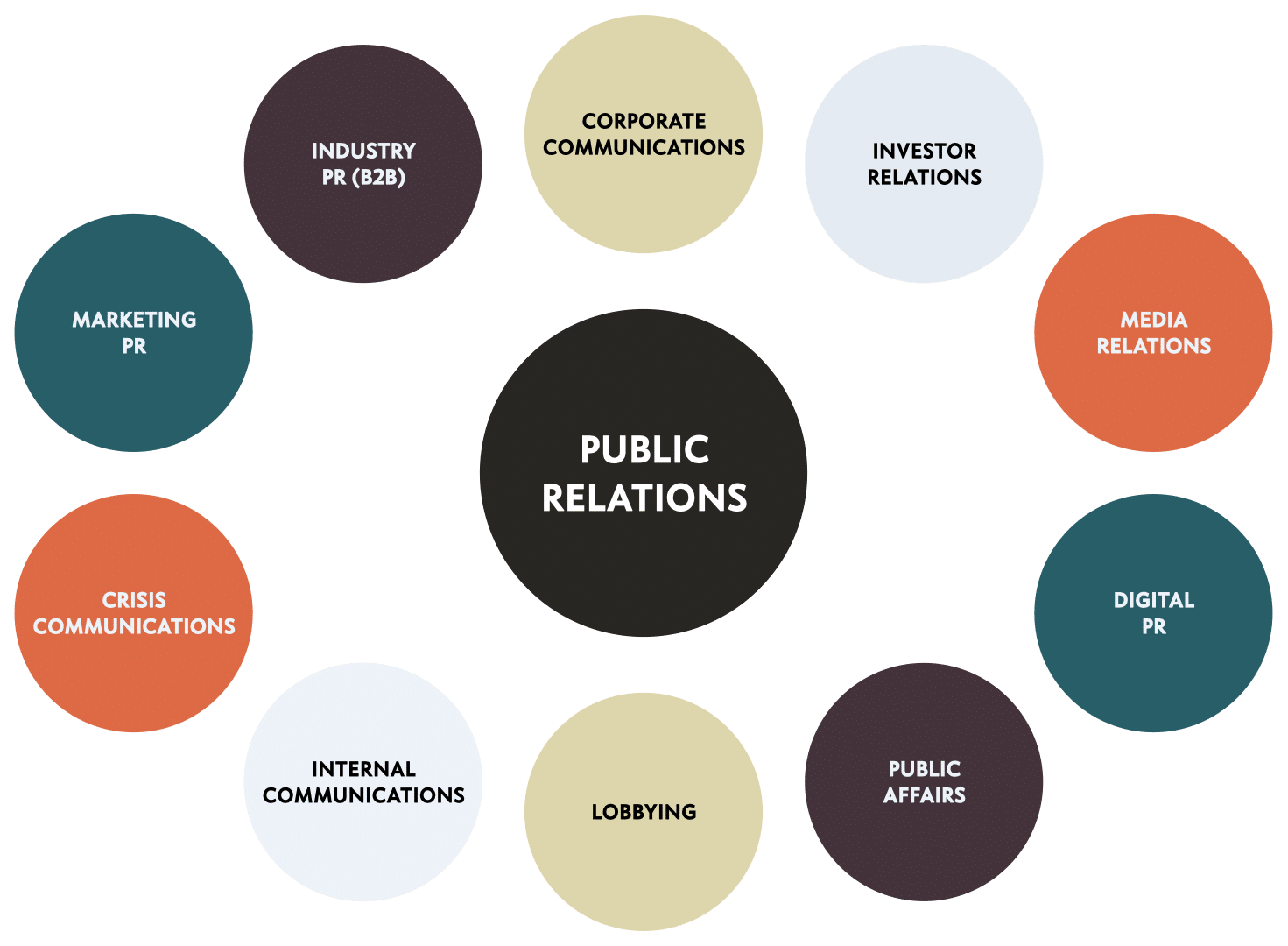ROI and PR are like oil and water — they don’t mix well.
Having worked in the PR industry for many years, I know how inflammatory such a statement might be.
Many PR professionals and academics dream of a future where our industry can showcase our worth by demonstrating concrete ROI results.
Maybe we’re wrong?
The Basic PR Model
To get us started, let’s look at a basic stakeholder model for public relations:

Spin Academy | Online PR Courses
The Stakeholders in Public Relations
In public relations (PR), we often discuss stakeholders. And our PR specialisations are named based on which PR stakeholder group we’re responsible for managing.
“In a corporation, a stakeholder is a member of ‘groups without whose support the organisation would cease to exist’, as defined in the first usage of the word in a 1963 internal memorandum at the Stanford Research Institute. The theory was later developed and championed by R. Edward Freeman in the 1980s. Since then it has gained wide acceptance in business practice and in theorising relating to strategic management, corporate governance, business purpose and corporate social responsibility (CSR).”
Source: Wikipedia 1Stakeholder (corporate). (2023, October 27). In Wikipedia. https://en.wikipedia.org/wiki/Stakeholder_(corporate)
The PR Stakeholder Model
Developing and maintaining relationships with various stakeholders is a significant challenge for PR professionals since their information needs are typically very different. 2A widespread misconception is that the PR function only deals with journalists (Media Relations) and product promotion (Marketing PR). However, such work represents only a tiny fraction of all the … Continue reading
“Public relations distinguishes itself from marketing by focusing on the stakeholder-organization relationship, which comprises mutual orientation around a common interest point and a multiplicity of stakes.”
Source: Public Relations Review 3Smith, B. (2012). Public relations identity and the stakeholder – organization relationship: A revised theoretical position for public relations scholarship. Public Relations Review, 38, 838 – 845. … Continue reading
Learn more: Stakeholders in Public Relations
💡 Subscribe and get a free ebook on how to get better PR ideas.
Without getting too hung up on establishing an exact definition of PR, the value of PR can be seen as the total value of all the relationships mentioned above.
ROI in Marketing vs PR
With the basic PR model in mind, let me make a distinct point:
If an organisation invests nothing in marketing, there’s no marketing.
If an organisation invests nothing in PR, there’s still PR.
Or another way to put it:
No investments in marketing = the return on marketing is zero.
No investments in PR = the return of PR is still a number.
So, does PR work for the ROI definition?
ROI = net income/cost of investment
It should be evident that the basic ROI model lacks fundamental variables to be useful for PR.
Need more convincing? Let’s keep going.
Two Unsolvable Problems
Can’t we make the ROI model work anyway?
Perhaps we can balance the net incomes (beforet0 and aftert1 the PR investment)?
Like this:
ROI = (net incomet1 — net incomet0) / cost of investment
There are severe problems with this approach:
One problem is that the return on the PR investment is a fluctuating valuation rather than a net income; it’s not “money in the bank.”
This creates an imbalance in the formula:
ROI = (valuationt1 — valuationt0) / cash loss
The next problem is establishing validity; how could we ever calculate the value of t=1 if the organisation never made those PR investments?
Example:
An organisation faces a severe crisis, but the PR function manages the situation ideally and minimises the loss of a) net income and b) brand value.
To calculate the value of the investment, we must know how severely the crisis would’ve impacted the organisation without the PR investment. Unless you find a way to visit parallel timelines, there’s no way of finding this out.
And even if we find a method of approximation, there’s still an actual loss of value — which puts the ROI in the red.
The Oil and Water Analogy
So, what does all of this mean in a practical sense?
It means that ROI and PR are like oil and water.
They don’t mix well.
Those who don’t appreciate my initial logic may instead consider that we’ve been trying to establish ROI for PR since the start of our profession — without success.
Our lack of progress forces us to consider the alternatives:
Either ROI or PR don’t mix.
Or we’re just too stupid to make it work.
Or, we accept that PR requires a specific ROI model that shouldn’t be compared. This means, for instance, that an organisation can’t benchmark the general ROI model of marketing against the particular ROI model of PR because it’s… apples and pears.
ROI and PR: A Fork in the Road
“Insanity is doing the same thing over and over and expecting different results.”
— Albert Einstein
If my suggested logic does not convince you, or if you think I’m mischaracterising or over-simplifying the practice of establishing ROI, that’s fine.
Regardless, we’re still left at a fork in the PR road:
a) If we’re all about apples and pears, we can keep discussing the ROI of PR academically, but it’ll be useless in practice.
b) If we’ve been too stupid this far, we’ll have to keep trying — and perhaps get more competent people to join our ranks.
c) Or, we could decide that enough is enough, cut our losses and start focusing on something with a better potential of being useful.
How To Demonstrate PR Value
For my preferred option c) above, I’d suggest the following principles for establishing the value of investing in PR activities:
Measuring Attitudes and Behaviours

Spin Academy | Online PR Courses
How To Measure Public Relations
How do you measure public relations (PR)? I recommend measuring attitudes and behaviours using questionnaires, rating scales, interviews, reports (logs, journals, diaries, etc.), and observations.
My recommendation: I recommend the Sociological Method for getting valuable and actionable results from measuring public relations. This means measuring attitudes and behaviours. 4Silfwer, J. (2021, March 4). Methods of Measuring Public Relations. Doctor Spin | The PR Blog. https://doctorspin.net/measuring-public-relations/
There are a few things to think about to measure attitudes and behaviours correctly. 5Educational Communications and Technology. (2001, August 3). 34.5 Measuring Attitudes. The Handbook of Research for Educational Communications and Technology. … Continue reading
Attitude Measurements in PR
An attitude measurement should meet the following criteria:
There are four main types of attitude measurement approaches:
There are four main types of attitude measurement methods:
I recommend using questionnaires and standardised interviews for public relations measurements:
Validity. Attitudes are psychological, so I strive to clarify what I want to measure, nothing more, nothing less. And I never add any unnecessary complexity.
Reliability. People experience the world differently. But even if attitude measurements aren’t exact, their usefulness for PR more than makes up for it.
Learn more: How To Measure Public Relations
💡 Subscribe and get a free ebook on how to get better PR ideas.
Still not convinced? I accept that.
As noted above, I’m not naïve enough to believe that one short blog post could resolve one of our industry’s most challenging dilemmas.
However, I do want to close with this:
By clinging to the ROI model, we represent the PR function at the C‑level by demonstrating how much net income we generate for organisations.
Mark my words: This is a battle we’ll never win.
Instead, we must demonstrate how we’re increasing shareholder value, creating room for the organisation to grow, mitigating potential losses, and safeguarding future revenue.
Any boardroom would be mad not to invite such a PR function.

Thanks for reading. Please consider sharing my public relations blog with other communication and marketing professionals. If you have questions (or want to retain my PR services), please contact me at jerry@spinfactory.com.
ANNOTATIONS
| 1 | Stakeholder (corporate). (2023, October 27). In Wikipedia. https://en.wikipedia.org/wiki/Stakeholder_(corporate) |
|---|---|
| 2 | A widespread misconception is that the PR function only deals with journalists (Media Relations) and product promotion (Marketing PR). However, such work represents only a tiny fraction of all the stakeholder relationships PR professionals must manage daily. |
| 3 | Smith, B. (2012). Public relations identity and the stakeholder – organization relationship: A revised theoretical position for public relations scholarship. Public Relations Review, 38, 838 – 845. https://doi.org/10.1016/J.PUBREV.2012.06.011 |
| 4 | Silfwer, J. (2021, March 4). Methods of Measuring Public Relations. Doctor Spin | The PR Blog. https://doctorspin.net/measuring-public-relations/ |
| 5 | Educational Communications and Technology. (2001, August 3). 34.5 Measuring Attitudes. The Handbook of Research for Educational Communications and Technology. https://members.aect.org/edtech/ed1/34/34 – 05.html |
























